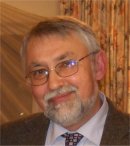|
Plenary
Lecture
Electrodynamics of Carbon Nanotubes: Principles, Models,
Device Applications and Open Questions

Professor S.
A. Maksimenko
Institute
for Nuclear Problems
Belarus State University
11 Bobruiskaya Str, Minsk 220030, Belarus
E-mail:
Sergey.maksimenko@gmail.com
Abstract:
A great progress has been achieved during last two
decade in the synthesis and fabrication of different
nanostructured artificial materials with fascinating
mechanical, electronic and optical properties
irreducible to properties of bulk media. Accompanied by
the impressive parallel development of the
characterization techniques and measurement
instrumentation, this process necessitates the revision
of traditional concepts of physics and chemistry of
condensed matter, adapting them to peculiarities of the
nanoworld and significantly extending our knowledge of
the nature of solids and our capabilities to control
their properties. Signalized by the prefix nano- these
peculiarities define the development of a variety of new
scientific and technological branches, such as
nanomechanics, nanoelectronics, nanooptics,
nanophotonics, nanosensorics, etc.
Following this general trend, a research discipline –
nanoelectromagnetics – is introduced as a synthesis of
macroscopic electrodynamics and microscopic theory of
electronic properties of different nanostructures. The
approach is exemplified by carbon nanotubes (CNTs) and
briefly touches upon other nanocarbon forms.
The method of effective boundary conditions is shown to
be a universal tool for the study of electrodynamic
problems of nanotubes. A set of physical effects, which
emerge from the interaction of light with CNTs is
described. Linear electrodynamics of nanotubes,
nonlinear optical effects in nanotubes and foundations
of quantum electrodynamics in nanotubes are discussed. A
strong slowing down of surface waves in CNTs is
demonstrated and the concept of nanotube as a surface
wave nanowaveguide in the infrared and terahertz range
is introduced. Theoretical analysis of the scattering
pattern and the absorption cross-section of a
single-walled finite-length CNT, multi-wall CNT and CNT
bundle is presented. Comparison with experimental
results is carried out allowing qualitative physical
interpretation of low-frequency (far-IR and terahertz)
absorption band observed in experiments. Potentiality of
CNTs as interconnectors and transmission lines is
demonstrated. Antenna properties of single- and
multi-walled CNTs and CNT bundles are described and the
thermal radiation of isolated CNT is shown to be
strongly different from the black-body radiation
allowing the thermal antenna concept. Potentiality of
CNTs for the IR photothermolysis of living cells is
discussed. Strong local field enhancement is predicted
to be inherent to metallic CNTs in the near-field zone
providing necessary mechanism for far-IR and terahertz
near-field optics. The idea of the CNT as monomolecular
analog of the free electron laser is proposed and
discussed. The formalism of electrodynamics of lossy
dispersive media is applied to the problem of
spontaneous radiation of an excited atom in the carbon
nanotube. Prospective problems of electrodynamics of
CNTs are discussed.
Brief Biography of the Speaker:
Professor Sergey A. Maksimenko was born in Belarus in
1954. He received a M.S. degree in physics of heat and
mass transfer from Belarus State University, Minsk, in
1976; a Ph.D. degree in theoretical physics from Belarus
State University in 1988; and a Sc.D. degree in
theoretical physics from the Institute of Physics,
Minsk, in 1996. He is currently a Head of Laboratory of
Electrodynamics of nonhomogeneous media at the Institute
for Nuclear Problems at Belarus State University, Minsk,
Belarus. He also teaches Physics of Nanostructured
Materials at the BSU physical department. He has
authored or coauthored more than 150 conference and
journal papers. In 2003, 2004, and 2006 Prof. Maksimenko
co-chaired Int. Conference “Nanotubes and Nanowires” as
a part of SPIE's 48th Annual Meeting, 2003, San Diego,
Int. Conference “Nanomodeling” as a part of SPIE's 49th
Annual Meeting, 2004, Denver, and Int. Conference
“Nanomodeling II” as a part of SPIE’s Optics &
Photonics, 2006, San Diego, and Belarus-India joint
seminar on Nanoscience and Nanotechnology, 2005,
Hyderabad, India. He is the associated editor of the
SPIE’s Journal of Nanophotonics. His current research
interests are electromagnetic wave theory and
electromagnetic processes in quasione- and
zero-dimensional nanostructures in condensed matter.
|
